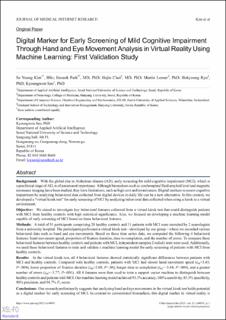Please use this identifier to cite or link to this item:
https://doi.org/10.21256/zhaw-30689| Publication type: | Article in scientific journal |
| Type of review: | Peer review (publication) |
| Title: | Digital marker for early screening of mild cognitive impairment through hand and eye movement analysis in virtual reality using machine learning : first validation study |
| Authors: | Kim, Se Young Park, Jinseok Choi, Hojin Loeser, Martin Ryu, Hokyoung Seo, Kyoungwon |
| et. al: | No |
| DOI: | 10.2196/48093 10.21256/zhaw-30689 |
| Published in: | Journal of Medical Internet Research |
| Volume(Issue): | 25 |
| Page(s): | e48093 |
| Issue Date: | 20-Oct-2023 |
| Publisher / Ed. Institution: | JMIR Publications |
| ISSN: | 1438-8871 |
| Language: | English |
| Subjects: | Digital marker; Machine learning; Alzheimer disease; Dementia; Virtual reality; Digital health; Artificial intelligence |
| Subject (DDC): | 006: Special computer methods 616.8: Neurology, diseases of nervous system |
| Abstract: | Background: With the global rise in Alzheimer disease (AD), early screening for mild cognitive impairment (MCI), which is a preclinical stage of AD, is of paramount importance. Although biomarkers such as cerebrospinal fluid amyloid level and magnetic resonance imaging have been studied, they have limitations, such as high cost and invasiveness. Digital markers to assess cognitive impairment by analyzing behavioral data collected from digital devices in daily life can be a new alternative. In this context, we developed a “virtual kiosk test” for early screening of MCI by analyzing behavioral data collected when using a kiosk in a virtual environment. Objective: We aimed to investigate key behavioral features collected from a virtual kiosk test that could distinguish patients with MCI from healthy controls with high statistical significance. Also, we focused on developing a machine learning model capable of early screening of MCI based on these behavioral features. Methods: A total of 51 participants comprising 20 healthy controls and 31 patients with MCI were recruited by 2 neurologists from a university hospital. The participants performed a virtual kiosk test—developed by our group—where we recorded various behavioral data such as hand and eye movements. Based on these time series data, we computed the following 4 behavioral features: hand movement speed, proportion of fixation duration, time to completion, and the number of errors. To compare these behavioral features between healthy controls and patients with MCI, independent-samples 2-tailed t tests were used. Additionally, we used these behavioral features to train and validate a machine learning model for early screening of patients with MCI from healthy controls. Results: In the virtual kiosk test, all 4 behavioral features showed statistically significant differences between patients with MCI and healthy controls. Compared with healthy controls, patients with MCI had slower hand movement speed (t49=3.45; P=.004), lower proportion of fixation duration (t49=2.69; P=.04), longer time to completion (t49=–3.44; P=.004), and a greater number of errors (t49=–3.77; P=.001). All 4 features were then used to train a support vector machine to distinguish between healthy controls and patients with MCI. Our machine learning model achieved 93.3% accuracy, 100% sensitivity, 83.3% specificity, 90% precision, and 94.7% F1-score. Conclusions: Our research preliminarily suggests that analyzing hand and eye movements in the virtual kiosk test holds potential as a digital marker for early screening of MCI. In contrast to conventional biomarkers, this digital marker in virtual reality is advantageous as it can collect ecologically valid data at an affordable cost and in a short period (5-15 minutes), making it a suitable means for early screening of MCI. We call for further studies to confirm the reliability and validity of this approach. |
| URI: | https://digitalcollection.zhaw.ch/handle/11475/30689 |
| Fulltext version: | Published version |
| License (according to publishing contract): | CC BY 4.0: Attribution 4.0 International |
| Departement: | School of Engineering |
| Appears in collections: | Publikationen School of Engineering |
Files in This Item:
| File | Description | Size | Format | |
|---|---|---|---|---|
| 2023_Kim-etal_Early-screening-of-mild-cognitive-impairment.pdf | 1.88 MB | Adobe PDF |  View/Open |
Show full item record
Kim, S. Y., Park, J., Choi, H., Loeser, M., Ryu, H., & Seo, K. (2023). Digital marker for early screening of mild cognitive impairment through hand and eye movement analysis in virtual reality using machine learning : first validation study. Journal of Medical Internet Research, 25, e48093. https://doi.org/10.2196/48093
Kim, S.Y. et al. (2023) ‘Digital marker for early screening of mild cognitive impairment through hand and eye movement analysis in virtual reality using machine learning : first validation study’, Journal of Medical Internet Research, 25, p. e48093. Available at: https://doi.org/10.2196/48093.
S. Y. Kim, J. Park, H. Choi, M. Loeser, H. Ryu, and K. Seo, “Digital marker for early screening of mild cognitive impairment through hand and eye movement analysis in virtual reality using machine learning : first validation study,” Journal of Medical Internet Research, vol. 25, p. e48093, Oct. 2023, doi: 10.2196/48093.
KIM, Se Young, Jinseok PARK, Hojin CHOI, Martin LOESER, Hokyoung RYU und Kyoungwon SEO, 2023. Digital marker for early screening of mild cognitive impairment through hand and eye movement analysis in virtual reality using machine learning : first validation study. Journal of Medical Internet Research. 20 Oktober 2023. Bd. 25, S. e48093. DOI 10.2196/48093
Kim, Se Young, Jinseok Park, Hojin Choi, Martin Loeser, Hokyoung Ryu, and Kyoungwon Seo. 2023. “Digital Marker for Early Screening of Mild Cognitive Impairment through Hand and Eye Movement Analysis in Virtual Reality Using Machine Learning : First Validation Study.” Journal of Medical Internet Research 25 (October): e48093. https://doi.org/10.2196/48093.
Kim, Se Young, et al. “Digital Marker for Early Screening of Mild Cognitive Impairment through Hand and Eye Movement Analysis in Virtual Reality Using Machine Learning : First Validation Study.” Journal of Medical Internet Research, vol. 25, Oct. 2023, p. e48093, https://doi.org/10.2196/48093.
Items in DSpace are protected by copyright, with all rights reserved, unless otherwise indicated.